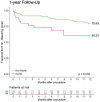Heyde syndrome: prevalence and outcomes in patients undergoing transcatheter aortic valve implantation
- PMID: 34302190
- PMCID: PMC8639542
- DOI: 10.1007/s00392-021-01905-z
Heyde syndrome: prevalence and outcomes in patients undergoing transcatheter aortic valve implantation
Abstract
Background: Heyde syndrome (HS) is known as the association of severe aortic stenosis (AS) and recurrent gastrointestinal bleeding (GIB) from angiodysplasia. Data on the prevalence of HS and results after TAVI remain scarce.
Methods: 2548 consecutive patients who underwent TAVI for the treatment of AS from 2008 to 2017 were evaluated for a history of GIB and the presence of HS. The diagnosis of HS was defined as a clinical triad of severe AS, a history of recurrent GIB, and an endoscopic diagnosis of angiodysplasia. These patients (Heyde) were followed to investigate clinical outcomes, bleeding complications and the recurrence of GIB and were compared to patients with GIB unrelated to HS (Non-Heyde).
Results: A history of GIB prior to TAVI was detected in 190 patients (7.5%). Among them, 47 patients were diagnosed with HS (1.8%). Heyde patients required blood transfusions more frequently compared to Non-Heyde patients during index hospitalization (50.0% vs. 31.9%, p = 0.03). Recurrent GIB was detected in 39.8% of Heyde compared to 21.2% of Non-Heyde patients one year after TAVI (p = 0.03). In patients diagnosed with HS and recurrent GIB after TAVI, the rate of residual ≥ mild paravalvular leakage (PVL) was higher compared to those without recurrent bleeding (73.3% vs. 38.1%, p = 0.05).
Conclusion: A relevant number of patients undergoing TAVI were diagnosed with HS. Recurrent GIB was detected in a significant number of Heyde patients during follow-up. A possible association with residual PVL requires further investigation to improve treatment options and outcomes in patients with HS.
Keywords: Angiodysplasia; Gastrointestinal bleeding; Heyde syndrome; TAVI.
© 2021. The Author(s).
Conflict of interest statement
Dr. Seiffert received travel support from Abbott Vascular, Biotronik, and Edwards Lifesciences, speaker honoraria from Abiomed, Amgen, AstraZeneca, Bayer Healthcare, Boehringer Ingelheim, Boston Scientific, Bristol-Myers Squibb, Philips, Medtronic, and Shockwave Medical, and consulting honoraria from Boston Scientific and Shockwave Medical. Dr. Conradi is a proctor for and received speaker honoraria as well as travel compensation from JenaValve, Edwards Lifesciences and Boston Scientific, and received speaker honoraria and travel compensation from Medtronic and is a consultant for Edwards Lifesciences. Dr. Westermann received speaker honoraria from Abiomed, AstraZeneca, Bayer and Novartis. Dr. Schofer received travel compensation from Edwards Lifesciences and St. Jude Medical, as well as speaker honoraria and travel compensation from Boston Scientific. Dr. Ludwig received travel compensation from Edwards Lifesciences. All reported honoraria and travel compensation are outside the submitted work. All other authors report no conflict of interest.
Figures



References
-
- HEYDE., C. E. Gastrointestinal bleeding in aortic stenosis (letter). N Engl J Med 1958;259(4):196.
MeSH terms
LinkOut - more resources
Full Text Sources
Medical
Research Materials

